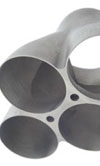Advanced Materials
 Last month we discussed the aluminium alloy AlSi10Mg and the fact that it can now be processed by means of a new manufacturing process. It is only because of the fact parts can be made of this material by this process that I chose to categorise it as being 'advanced'. The picture which accompanied the article showed a small aerospace part which would be impossible to make by other means.
Last month we discussed the aluminium alloy AlSi10Mg and the fact that it can now be processed by means of a new manufacturing process. It is only because of the fact parts can be made of this material by this process that I chose to categorise it as being 'advanced'. The picture which accompanied the article showed a small aerospace part which would be impossible to make by other means.
There is now, however, a wide range of materials which can be processed by this particular method. If we consider the aluminium material to be advanced because of the opportunities that it offers us to make previously impossible forms, then we should also consider the other materials which can be processed by these means to be advanced.
Certainly one which might be of most interest to us as race engine designers and engineers is Titanium. As we might reasonably expect, the titanium alloy which is available is Ti-6Al-4V. Owing to the fact that the stock from which the metallic powder is made is available at reasonable cost and, most importantly, of good quality, it is natural that this material has been chosen over some of the other available alloys. Also, if people are considering replacing titanium parts with ones made by this new process, there is no risk from switching to an unknown alloy. The tensile properties of the alloy are equally as good as the wrought alloy given that the process was in its infancy only a few years ago, this represents great progress. More remarkably, the available fatigue data for this material shows that it is comparable to the wrought material.
In addition to aluminium and titanium, there are other materials which might be of interest. The main target market for this process is the aerospace industry, and so it is no surprise that we find two materials available which we would normally term superalloys intended for high-temperature use. There are Cobalt-Chromium-Molybdenum alloys and one of the Inconel alloys is also available. Whilst cobalt-chrome might not be a material that we are familiar with, there are a number of applications of inconel alloys for racing purposes. Certainly, as we have mentioned elsewhere, Inconel alloys are widely used for exhausts and at a recent trade show, experimental exhaust parts were shown by EOS (see accompanying picture) as a demonstration of the possibilities that the technology offers. Such was the quality of the part in question that one had to examine it carefully to see that it wasn't made by the normal method, e.g. fabrication.
Two precipitation-hardening stainless steels are available, and again, these don't seem to find widespread use on racing engines.
One of the maraging steel alloys is among the choice of alloys and this may be of interest to some of our readers. Maraging steels differ from most steels in that in their as-quenched state, they are soft and require a low temperature aging process in order to achieve their final hardened state. In this regard we might think of the hardening process as being similar to that of aluminium alloys.
This new manufacturing process turns some widely-available and normally unremarkable materials into advanced materials, and clearly the wide range of useful materials offers us great possibilities for making novel engine components.
Fig. 1 - The experimental exhaust part was made by laser sintering of metal powders (Courtesy of EOS / 3TRPD)
Written by Wayne Ward